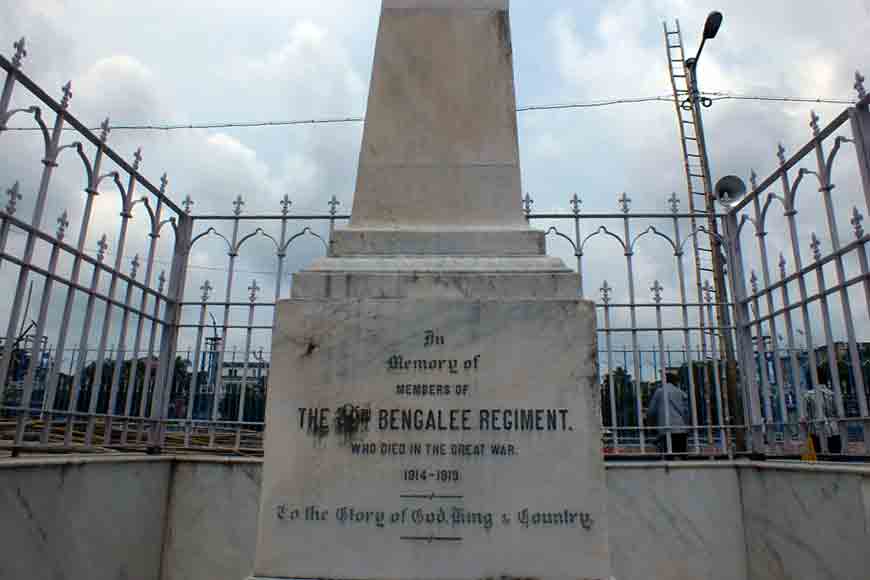When will Kolkata learn to protect heritage structures?

Kolkata had been the capital of the erstwhile British Raj and still boasts of a rich cultural history. The city’s long-lost history doesn’t just lie in the buildings of tourist interest, but in its abandoned buildings, old winding streets, laid back nooks and corners. But well, some of the lesser known architectural wonders of the city lie in obscurity and at times one wonders why? Take for example the Memorial dedicated to Bengali soldiers who fought for the British in World War I, afountain for a Greek trader and a haunted house--- all abandoned and long-forgotten edifices tucked in different parts of Kolkata.

In 1903, the Bengal Army was absorbed into the British Indian Army, yet the 49th Bengali Regiment was deployed to fight in Mesopotamia, which they did with the hope that ‘self- rule’ would come to Indians if the war ended. A marble monument was built in memory of the brave soldiers who lost their lives in that war. One gets to see the memorial still, at the entrance of the east gate of College Square. However, it is very difficult to spot it at one go since posters and leaflets are stuck on it and the local footpath-dwellers dry their clothes there. When shall we wake up and learn to protect these heritage structures?

Or have you ever tried entering the Clive House? A plaque at the entrance says Lord Clive’s Country House, 1757 – 1760, 1756 – 1767. But the entrance cannot be approached. Robert Clive had introduced changes in this particular building’s architecture and added an upper storey. He also laid extensive gardens and walk-ways.The origin of Clive House, also known as Burra Kothi, still remains a mystery. According to local legend, the mound on which Clive House stands was built in a single night and locals believe the grounds and the house are haunted.
It was in fairly good shape until the 1900s and then parts of the house started crumbling. In 2001, excavations were carried out and remnants of a 2,000-year-old civilization was discovered on the site. Today the House is surrounded by apartment buildings and modern architecture. It is a protected monument under the Archaeological Survey of India but is in a decrepit shape, largely neglected and forgotten.

Same with the Panioty Fountain of Curzon Park, located in the middle of a major business district. A hunt around the north-west corner of Surendra Nath Banerjee Park (now renamed ‘Bhasha Uddyan’), will bring you to the dilapidated structure of a fountain, surrounded by an unkempt garden. This fountain was inspired by Demetrius Panioty, a member of the Panioty family who had moved to India from Greece as traders back in 1750. Panioty, who wrote for the Bengal Secretariat, later became Assistant Private Secretary to Governor General Ripon and several of his successors. In 1895, three years after his death, out of fondness for the man and his dedication to service, Lord Curzon had this marble drinking water fountain installed.

And then there are remnants of McDonell Drinking Fountain. On Esplanade Row West, opposite Calcutta’s historic Town Hall, and near the High Court, lies a forgotten monument of Kolkata. The Neo-Classical monument, located within the premises of the West Bengal State Legislature, is a drinking fountain, with a lion’s head protruding from the front and a decorative urn on top. The marble plaque which identified the man the monument was dedicated to is long gone. This is the monument dedicated to Sir William Fraser McDonnell who joined the Bengal Civil Service in 1850. On two sides of the monument are the dates 1850 and 1886, which mark the 36 years that McDonnell spent with the service. He received the Victoria Cross for “great coolness and bravery” (which is on display in the Lord Ashcroft Gallery at the Imperial War Museum, London) for saving 35 members of the British Troops from “incessant enemy fire” that showered down on their boat during the retreat of the soldiers from Arrah.
Today, the monument is unfortunately in a wretched state with its identifying markers fading away into nothingness. Part of the carved lion spout is broken and the water has long run dry. The railing around it is used by locals to dry their laundry.










